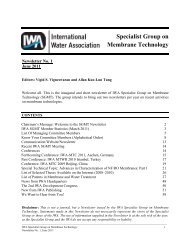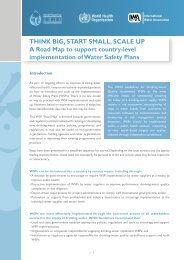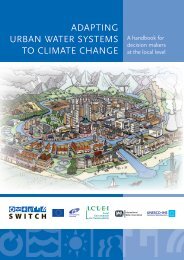Sanitation 21 planning framework - IWA
Sanitation 21 planning framework - IWA
Sanitation 21 planning framework - IWA
- No tags were found...
You also want an ePaper? Increase the reach of your titles
YUMPU automatically turns print PDFs into web optimized ePapers that Google loves.
<strong>Sanitation</strong> <strong>21</strong>cleanliness and convenience/ privacy/safety,occasionally health).• Priority – household having sufficient cash andinterest to steer expenditure towards sanitation(i.e. deciding to build a latrine rather than buy asewing machine or an extra TV)• Access – households being able to get theservice (households may place a priority onsanitation but they will not make an investmentif they cannot find a mason to build a toilet or ifthey do not meet legal requirements for a formalconnection to the sewerage network for example• Influence – households may often hesitate inmaking an investment in sanitation if they areunsure about the ‘downstream’ system. Forexample where utilities have a poor reputationfor operating and maintaining collectorsewers households may not want to invest ina connection if they feel they are powerlessto influence the utility’s performance in theirarea. Such hesitations are often overcome forexample through the intermediation of a localcouncillor who can act as an intermediary fora poor community with the utility company.Utilities which develop a track record of goodperformance may find it increasingly easyto encourage households to connect to theirnetworks.Households who have no prior experience of aworking sanitation system thus move graduallytowards being willing to invest in householdlevel infrastructure and services. Their attitudeat any time is impacted both by internal factors(household knowledge, wealth, priorities) andexternal factors (performance of the city/ utility,availability of artisans etc) .3.2.3 At the neighbourhood and ward/district levelThe interests of the neighbourhood are still likelyto be heavily focused on cleanliness and statusand some urban communities also see collectiveservice delivery as a means to general stronger While it may seem strange for professionals working in areaswith well established sanitation systems that households maybe unwilling or unable to make investments in sanitation, it isimportant to recall that for most cities it is less than a 150 yearssince the existence of networked sanitation began to becomea norm, and in many cases less than 75 years since internalplumbing became standard for new-built dwellings.social cohesion; part of the development processitself. However, the ability of communities toexpress ideas and act may be severely constrained.Many have other priorities and in many casesthere is in fact no ‘community’ at all – simplypeople living in the same area in an atmosphere ofextreme stress.Like households though, community attitudesand interests change over time and are stronglyaffected by external factors such as levels ofpoverty and the nature of city authorities andutility service providers. Community capacitiesand cohesion may grow with other developmentactivities.The importance of the political ward/district willvary in different institutional contexts. In many casesthe boundaries between the ‘community’ and theward are blurred, particularly where local electedcouncillors are active. Interests at this level are stilllikely to focus on cleanliness and status but may alsoinclude health, particularly where responsibilities forhealth services are devolved to this level.In reality there may be one or more than onedomain at this level – each case needs to beassessed individually depending on the dynamicsof communities and the realities of politicalorganisation in any given city.3.2.4 The cityThe objectives of city authorities are stronglyimpacted by (a) who those authorities are and(b) the external incentives they face throughhigher levels of government (incentives whichmay be created by financial flows, penalties,electoral relationships and law). Generally at thecity level the focus shifts markedly away fromconvenience, status and access, towards protectingthe economy and environment of the city, andmeeting externally-established targets. Health alsobecomes more prominent here, as major outbreaksof disease impact directly on the political credibilityand economic attractiveness of the city. Wherefinancially independent utilities exist, financialconsiderations will also come into play at this level.3.2.5 Beyond the CityFinally beyond the city, considerations around themanagement of water resources, food resources,– 17 –
















